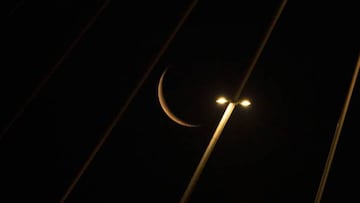Black Moon April 2022: what is it and how often does it occur?
On Saturday, most areas of the United States will experience a Black Moon - according to the term’s most common definition, at least.


There are several definitions for the term ‘Black Moon’, but it most commonly refers to the second new Moon in a single calendar month.
In most of the United States - but not, however, in areas on Pacific, Alaska and Hawaii Time - such a phenomenon will occur today, Saturday 30 April 2022.
How does a Black Moon occur?
A Black Moon, which happens about once every two and a half years, is caused because the lunar cycle doesn’t line up exactly with the length of our months.
It takes the Earth’s satellite 29.53 days to go from new Moon, to full Moon, and back to new Moon again. So if there is a new Moon on the first or second day of the month, there will also be one right at the end of the month - unless, of course, it’s February, which only lasts for 28 or 29 days.
Because the PT, AKT and HT time zones are behind the rest of the US, these parts of the country actually experienced their Black Moon last month. They witnessed a new Moon on 31 March, having already had one on the 2nd.
Alternative definitions of Black Moon
According to Time and Date, the name ‘Black Moon’ is also used to refer to: the third new Moon in a season with four new Moons (spring, summer, autumn and winter normally only have three each); a February with no new Moon, which occurs approximately once every 19 years; and a February with no full Moon, which also happens about once every 19 years.
See also:
“Once in a Blue Moon” = once every 2.5 years?!
A new Moon is the phase of the lunar cycle in which the Sun illuminates only the side of the Moon that we cannot see. A full Moon is the opposite: the side visible to us is completely lit up by our solar system’s star.
And just as there can be two new Moons in a calendar month, there can also be two full Moons. In this case, the second such Moon is known as a ‘Blue Moon’.
As a Blue Moon also occurs roughly once every two and a half years - not altogether infrequently - you might be asking yourself why we use the English phrase “once in a Blue Moon” to refer to something that seldom, or never, happens.
Well, that’s because the idiom doesn’t refer to this phenomenon. In fact, it far pre-dates the use of the term ‘Blue Moon’ to mean two full Moons in a month - a definition which Sky & Telescope’s Philip Hiscock has traced back to the Maine Farmers’ Almanac in 1937.
In a 2012 article, Hiscock explains that the notions of improbability and infrequency bound up in the phrase “once in a Blue Moon” are historically far more closely related to the simple expectation that the Moon will never literally turn blue.
Black Moon 2022 guide: April's rare second new moon https://t.co/Wflbv1bzln pic.twitter.com/J20nRQZT5o
— SPACE.com (@SPACEdotcom) April 26, 2022
Black Moon + solar eclipse
Because the satellite’s dark side is facing us when there is a new Moon, Saturday’s Black Moon won’t offer a huge amount to see - except for people in a narrow belt spanning the southeastern Pacific Ocean, the Antarctic and some South America countries such as Chile, Argentina, Uruguay, Bolivia and Peru.
Related stories
People in these areas will be treated to a partial solar eclipse, which occurs when the new Moon passes in front of the Sun, blocking part of the star from view.
Note: the image at the top of this article depicts a waning crescent Moon, the stage immediately before a new Moon.

